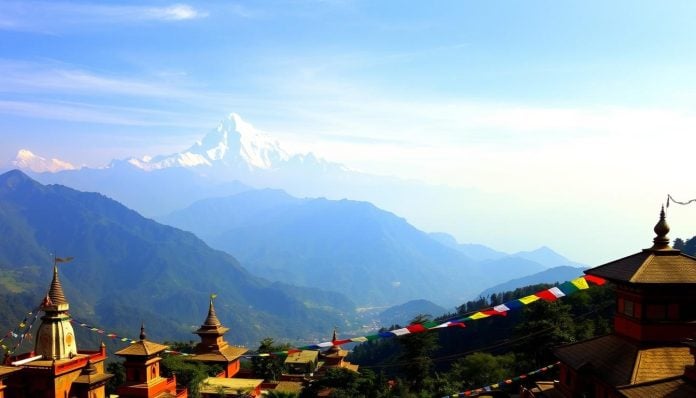Did you know Nepal offers more than just its high Himalayan peaks? It holds hidden gems and colorful cultural experiences to discover.
Nepal is famous for its diverse landscapes, vivid cultures, and rich history, all set before the beautiful Himalayas. It offers adventures and spiritual journeys. From Chitwan National Park’s wildlife to the peaceful lakes of Pokhara, Nepal’s best places mix nature’s beauty with cultural depth.
The Kathmandu Valley wows with ancient temples, detailed architecture, and lively markets. With seven monument zones in Kathmandu, each spot offers a unique look into Nepal. Places like Nagarkot offer views of eight Himalayan ranges, perfect for watching stunning sunrises and sunsets.
Exploring Nepal means trekking the Annapurna Circuit, visiting Buddha’s birthplace in Lumbini, or seeing Bhaktapur’s 55-Window Palace. Each spot has its own story. The Annapurna region alone shows off deserts, valleys, and farms, painting a picture of Nepal’s diverse landscapes. Get ready for Everest Base Camp treks in Khumbu and the tea estates in Ilam, near the world’s third-highest mountain, Mt Kanchenjunga. Join us as we explore the top destinations in Nepal and reveal its unique beauty.
Kathmandu: The Historical Heart of Nepal
Kathmandu is where history and modern life blend beautifully. This city is a magnet for tourists seeking to explore Nepal. Its cultural heritage shines through ancient architecture, sacred sites, and lively areas.
Swayambhunath Stupa
The Monkey Temple, or Swayambhunath Stupa, showcases stunning views of Kathmandu Valley. It’s a revered spot for both Hindu and Buddhist pilgrims. The stupa is known for its detailed carvings and the iconic eyes of Buddha.
Visitors here can enjoy the spiritual and dynamic atmosphere. This place is an ancient complex filled with divinity.
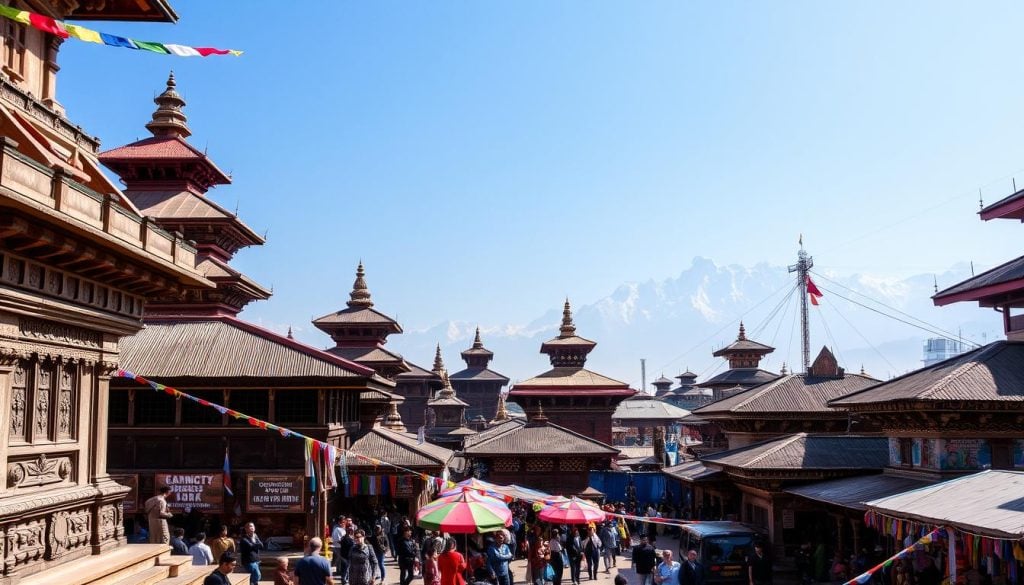
Pashupatinath Temple
Pashupatinath Temple sits along the Bagmati River. It’s a key site for Hindu worship and showcases Nepal’s temple design. This landmark attracts many yearly, especially during the Maha Shivaratri festival.
Entry is free for Indian nationals, but SAARC citizens need to pay NPR 1000.
Durbar Square
Durbar Square is at the center of old Kathmandu. Here, visitors find old palaces, courtyards, and temples. It’s a UNESCO site featuring the Hanuman Dhoka Royal Palace.
Locals enter for free, while foreigners pay NPR 1000. The square is alive with culture and history, a must-see in Kathmandu.
| Popular Tourist Attractions | Entry Fees | Timings |
|---|---|---|
| Swayambhunath Stupa | NPR 200 for foreigners NPR 50 for SAARC nationals Free for locals | Open 24 hours |
| Pashupatinath Temple | Free for Indians NPR 1000 for SAARC citizens | 4 a.m. to 7 p.m. |
| Durbar Square | NPR 1000 for foreigners NPR 200 for SAARC citizens Free for locals | 10 a.m. to 5 p.m. (closed on Saturdays) |
Kathmandu is also home to lively Thamel for shopping, the peaceful Garden of Dreams, and Boudhanath Stupa. Each spot offers a unique glimpse into Nepal’s culture and history. Venture into Kathmandu to feel the pulse of Nepal’s rich heritage and vivid culture.
Pokhara: The Tranquil Gem of Natural Beauty and Adventure
In the heart of Nepal lies the enchanting Pokhara Valley. It’s a top spot for anyone visiting Nepal. With stunning views, deep cultural roots, and thrilling activities, it’s perfect for everyone. Whether you love quiet nature or exciting adventures, Pokhara has something for you.
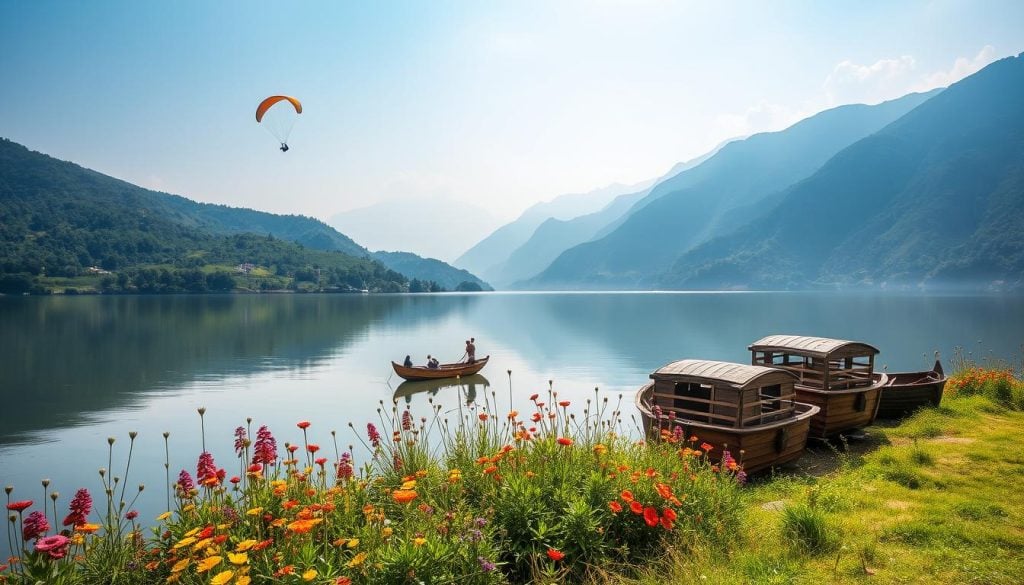
Phewa Lake
Phewa Lake is the second-biggest lake in Nepal and a high point of Pokhara. The lake shows the Annapurna and Machapuchare mountains as if they were in a mirror. You can rent boats to enjoy the quiet lake and listen to the water and birds. The Tal Barahi Temple, on the lake, brings a cultural flavor to your visit.
This temple is a beautiful place that gives a peek into the spiritual life here.
World Peace Pagoda
The World Peace Pagoda, or Shanti Stupa, sits on a hill as a symbol of peace. It’s a white building surrounded by green, offering great views of the area. Here, you can think quietly or learn about Buddhist beliefs.
Sarangkot
Sarangkot is known for amazing sunrise and sunset views. People love paragliding here because of the beautiful skies and mountains. It’s a top place for flying and taking stunning photos.
Pokhara offers lovely boat rides, peaceful moments at the World Peace Pagoda, and thrilling paragliding in Sarangkot. It’s a diverse place with a lot to do. Discover why it’s one of the best places to visit in Nepal.
Chitwan National Park: A Wildlife Haven
Chitwan National Park was founded in 1973. It marks Nepal’s entry into the realm of national parks. Spanning 932 square kilometers, it teems with varied species within its lush landscapes and vast meadows.
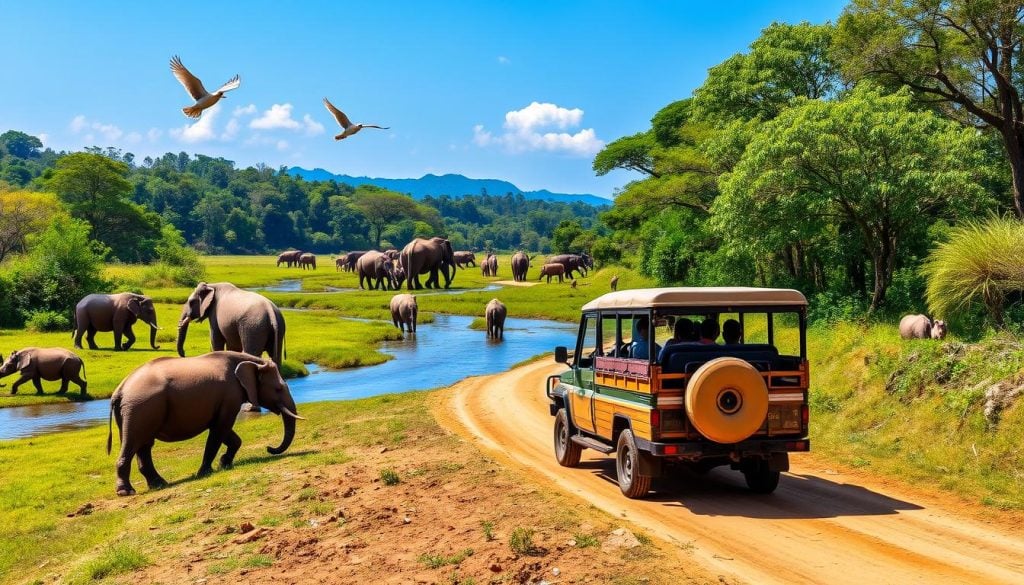
Home to over 700 species, Chitwan is particularly proud of its 540+ bird species. The park shines in conserving endangered species. It plays a key role in safeguarding the one-horned rhinoceros and the Royal Bengal tiger.
One-horned Rhinoceros
The one-horned rhinoceros stands as a symbol of Chitwan. This park is their second-largest sanctuary. It is vital in protecting these impressive beasts. Thanks to effective conservation, Nepal now hosts over 600 of these rhinos.
Royal Bengal Tiger
Chitwan is also home to the secretive Royal Bengal tiger. With more than 120 tigers, it’s an ideal spot for sightings. The dense forests and meadows of Chitwan create the perfect backdrop for these tigers.
Chitwan offers more than just rhinos and tigers. Visitors can enjoy elephant rides, jungle treks, and river safaris. These activities offer a deep dive into the park’s rich biodiversity. Visiting Chitwan enriches one’s appreciation for nature and highlights the critical task of saving endangered species.
Annapurna Base Camp Trek
The Annapurna Base Camp (ABC) trek is famous as one of Nepal’s top treks. It offers amazing mountain views. Covering about 110 kilometers, or 68.35 miles, it guides walkers right through the Annapurna range.
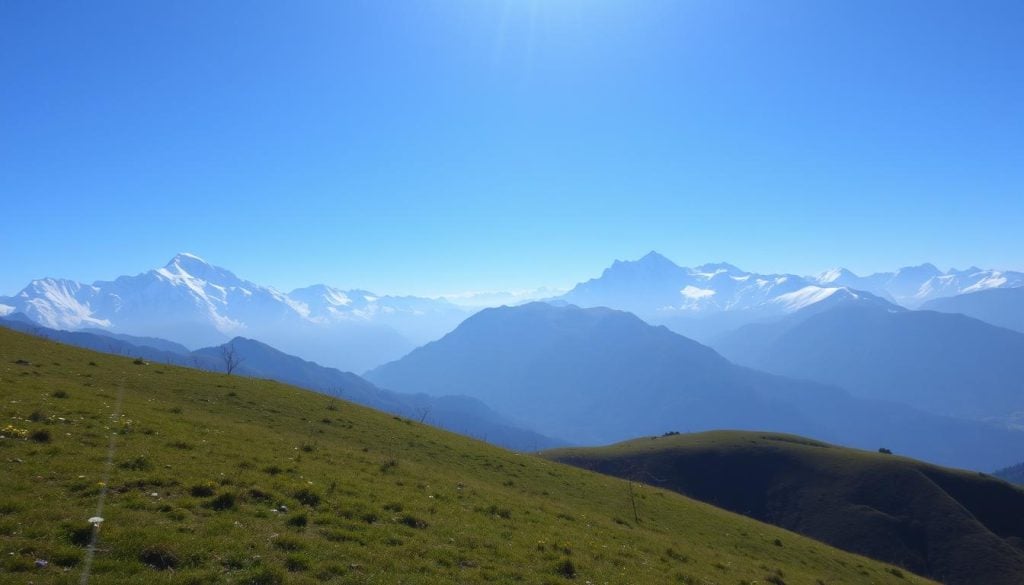
Poon Hill Trek
The Poon Hill Trek is an easier part of the ABC trail, perfect for those just starting. It begins at Naya Pul. Here, trekkers face a climb of about 3,500 stone steps to reach Ulleri. This village is up at 2,020 meters (6,627 feet) and presents a mix of challenge and beauty, with its jungle scenes.
To get to Ghorepani, you have to go up another 800 meters. It usually takes about 4 hours. The main event here is the sunrise at Poon Hill, which is at 3,210 meters (10,531 feet). People hike up at 4 am to see the dawn break over peaks like Annapurna South and Annapurna I. This trek is also rich in Nepalese culture.
Annapurna Circuit Trek
The Annapurna Circuit Trek is known for being a bigger challenge. It’s a favorite among experienced trekkers. This journey circles the Annapurna range, crossing everything from green forests to snowy passes.
Between Ulleri and Ghorepani, and then on to Tadapani, trekkers enjoy stunning views. Along the way, many stop at cozy tea houses. The cost for these stays ranges from 200-400 NPR. The path involves various climbs and descents. For instance, the ascent to Dovan reaches 2,600 meters (8,530 feet). The total climb is about 5,255 meters upwards and 5,405 meters going down.
The trek to Annapurna Base Camp starts from Chomrong, up at 2,140 meters (7,021 feet). Along this part, the iconic Machhapuchhre (Fish Tail Mountain) watches over you. This segment combines breathtaking nature with a deep dive into local culture. It stands out as a must-do among Nepal’s treks.
| Location | Elevation (meters) | Key Features | Tea House Cost (NPR) |
|---|---|---|---|
| Ulleri | 2,020 | Stone Steps, Jungle Landscape | 300 |
| Ghorepani | 2,874 | Poon Hill Sunrise | 200-400 |
| Tadapani | 2,630 | Scenic Valley and Mountain Views | 200-400 |
| Chomrong | 2,140 | Views of Machhapuchhre | 200-400 |
| Dovan | 2,600 | Climbs and Descents | 100-300 |
Everest Base Camp Trek
The Everest Base Camp Trek takes you to the base of the highest mountain in the world. It starts with a thrilling flight to Lukla Airport. This airport is high up at 2,850 meters and has a very short runway. Through diverse landscapes and cultures, you get a full experience of Mount Everest.
Namche Bazaar
Your journey begins through green valleys and small villages until you reach Namche Bazaar. Sitting at 3,440 meters, it’s known for its bustling Saturday market. The climb from Phakding to Namche is tough but offers incredible views and cultural experiences.
Sagarmatha National Park
The path leads through Sagarmatha National Park, a UNESCO World Heritage Site. It’s home to unique plants and animals found only in this high-altitude area. Here, stops at places like Dingboche help you get used to the high elevation. Trekking past the Thukla Memorial Pass at 4,700 meters, you’ll feel the thin air.
Kala Patthar
Reaching Everest Base Camp near Gorakshep is the highlight of the adventure. But before that, many trekkers scale Kala Patthar, at 5,545 meters. Its summit offers unmatched views of Everest, especially at sunrise, making it an essential part of the experience.
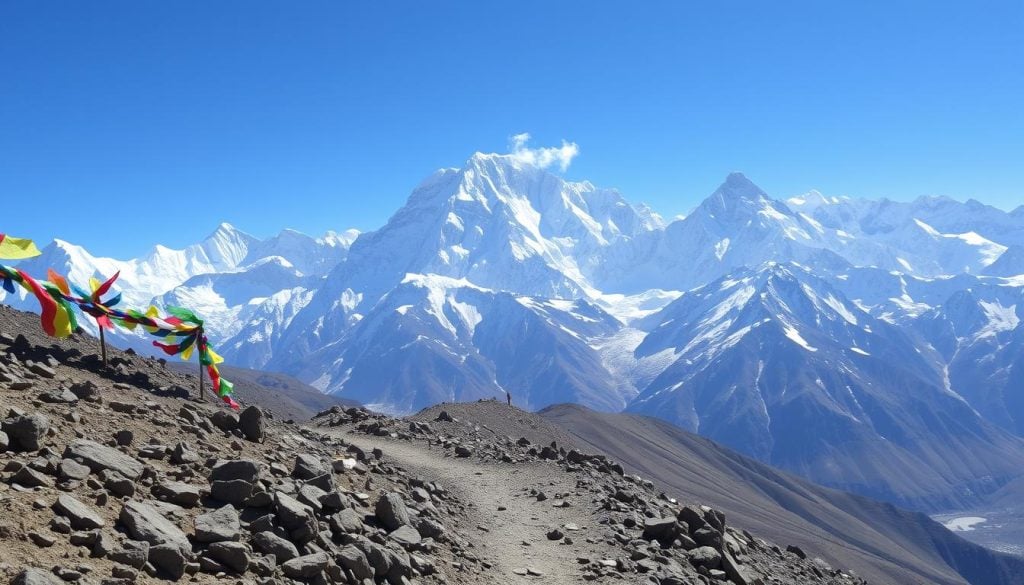
| Destination | Elevation (meters) | Route Information |
|---|---|---|
| Lukla Airport | 2,850 | Shortest runway at 1,729 feet, known for extreme landings |
| Namche Bazaar | 3,440 | Historic trading town, weekly market fair |
| Tengboche Monastery | 3,867 | Annual Mani Rimdu festival, significant Buddhist site |
| Thukla Memorial Pass | 4,700 | Many trekkers acclimatize here to adjust to the altitude |
| Everest Base Camp | 5,364 | Final goal of the trek, situated near Khumbu Icefall |
| Kala Patthar | 5,545 | Best vantage point for panoramic views of Mount Everest |
Lumbini: The Birthplace of Buddha
Lumbini is one of Nepal’s most sacred places, where Siddhartha Gautama, Lord Buddha, was born. It is packed with historical landmarks, attracting millions of people every year. This place offers peace, making it perfect for deep thinking and growing spiritually.
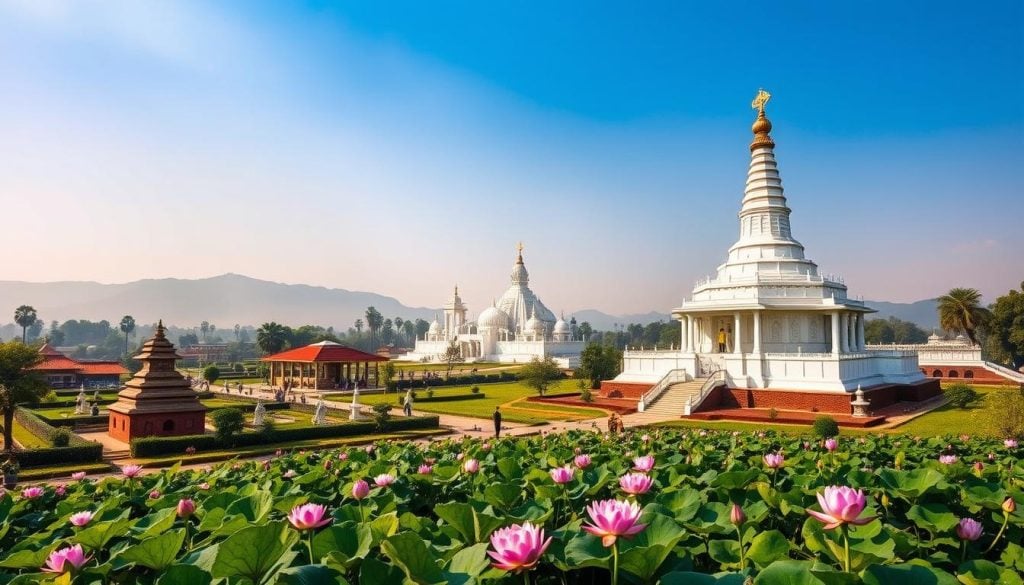
Maya Devi Temple
The Maya Devi Temple is where Queen Maya Devi had Gautama Buddha in 623 B.C. This holy place is a must-see in Lumbini, surrounded by old ruins and peaceful parks. It has been a UNESCO World Heritage Site since 1997, showing its global importance.
Monasteries and Meditation Centers
Lumbini is home to over 30 monasteries from countries like Japan and China. These sites are perfect for quiet meditation and learning. You can see beautiful buildings like the Royal Thai Monastery and Myanmar Golden Temple.
- The Panditarama Vipassana Center offers guided sessions for finding peace within.
- These monasteries are not just historical; they’re lively places to experience diverse Buddhist traditions.
Near Lumbini, you’ll find Tilaurakot, where Buddha grew up, and the Ramgram Pagoda, which holds Buddha’s relics. Lumbini also has a Crane Sanctuary for those who love birds and photography.
| Top Attractions in Lumbini |
|---|
| Maya Devi Temple |
| World Peace Pagoda |
| Lumbini Monastic Site |
| Royal Thai Monastery |
| Myanmar Golden Temple |
Visiting Lumbini lets you touch the heart of Buddhism and see important spiritual sites. With its historic sites and peaceful meditation centers, Lumbini carries a deep spiritual heritage.
Janakpur: The City of Ponds and Temples
Janakpur is among the top 10 must-visit places in Nepal, famed for its Maithili culture. It’s linked to Hindu mythology, showcased in the Ramayan. It draws visitors with its rich cultural heritage. You’ll find stunning Hindu temples and peaceful sacred pools here.
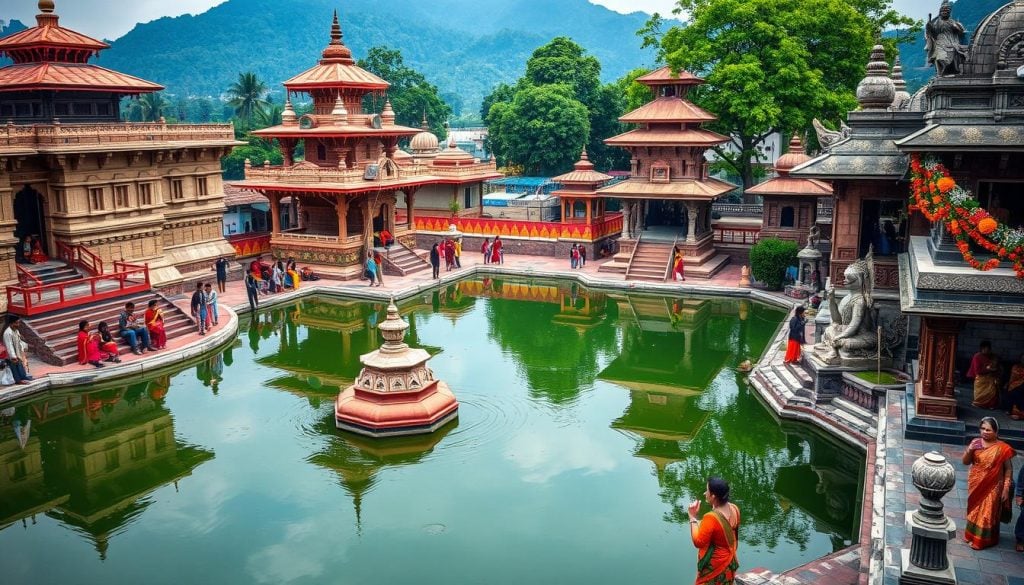
Janaki Mandir
In Janakpur stands the beautiful Janaki Mandir, built in the 19th century. It celebrates the union of Lord Ram and Sita. It is a key place showing Janakpur’s architectural beauty and religious depth. Entry to this stunning temple is free, making it a highlight among Nepal’s Hindu temples.
Sacred Pools and Ponds
Janakpur, known as the “City of Ponds,” has over 70 sacred ponds. Ganga Sagar and Dhanush Sagar Lakes are famous among them. They’re legendary and offer peaceful spots for boat rides. These ponds enhance Janakpur’s spiritual vibe, attracting photographers and visitors alike, especially at dawn and dusk.
| Attraction | Significance | Entry Fee |
|---|---|---|
| Janaki Mandir | 19th-century Hindu temple, symbolizing Lord Ram and Sita’s marriage | Free |
| Ganga Sagar Lake | Legendary pond ideal for relaxation and boat rides | N/A |
| Dhanush Sagar Lake | Historical importance tied to local myths | N/A |
| Shree Ram Janaki Biwah Mandir | Temple celebrating the marriage of Ram and Sita | Rs. 10 |
Exploring Janakpur means diving into Nepal’s rich cultural heritage. From the majestic Janaki Mandir to the calming sacred ponds, it’s a must-see for those interested in Hindu temples and Janakpur’s deep history.
Nagarkot: Gateway to the Himalayas
Nagarkot sits on a ridge, offering views of eight Himalayan ranges. It’s the top spot for enjoying Nepal’s panoramic views. This hill station is known for its peace and is a favorite among visitors. People from all over come to enjoy its serene atmosphere and beautiful scenery. Nagarkot welcomes everyone with its Himalayan vistas and peaceful countryside.
Mountain Views
The mountain views from Nagarkot are stunning. You can see the vast Himalayas from your spot. On clear days, you might even see Mount Everest. These breathtaking views are a must-see in Nepal. The green valleys and terraced fields around the peaks add to its beauty, creating a memorable scene.
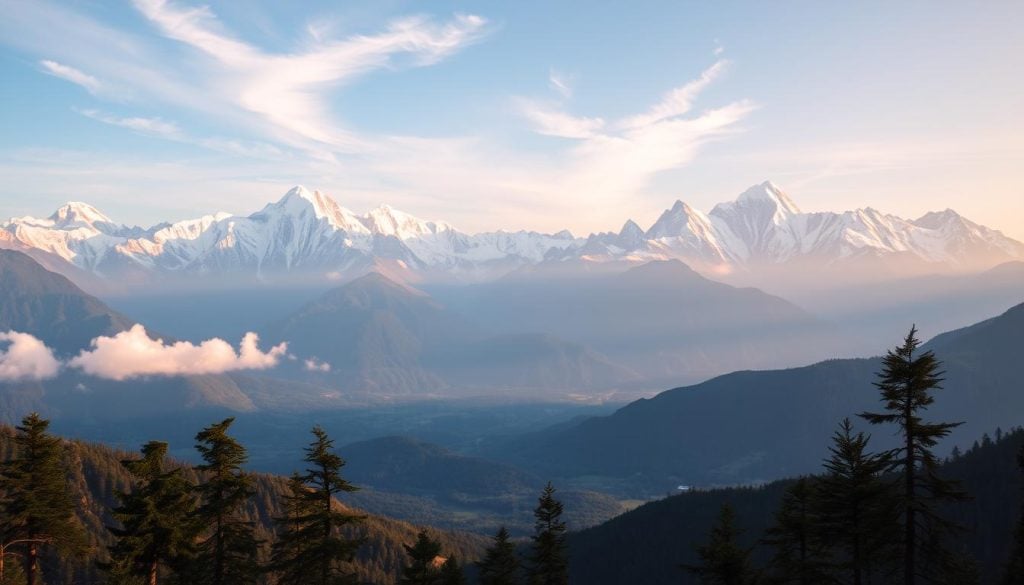
Best Sunrise Spots
Nagarkot is famous for its sunrise views. At dawn, sunlight lights up the snow-topped peaks, making for a beautiful color display. The morning sunrise view is among Nagarkot’s top experiences. There are many spots to watch this beauty, from towers to hidden lookouts. It attracts photographers and nature lovers alike with its stunning landscapes.
| Highlight | Benefit |
|---|---|
| Himalayan vistas | Unmatched panoramic views of eight Himalayan ranges |
| Nagarkot attractions | Peaceful rural setting offering breathtaking landscapes |
| Nepal panoramic views | Ideal locations to witness magnificent sunrises and sunsets |
The Khumbu Region: Home of Mount Everest
The Khumbu region is famous for its stunning sceneries. It is a special place for Himalayan expeditions and learning about culture. It’s where Mount Everest, the highest mountain, invites adventurers. You can trek and dive into Sherpa culture for an unforgettable journey.
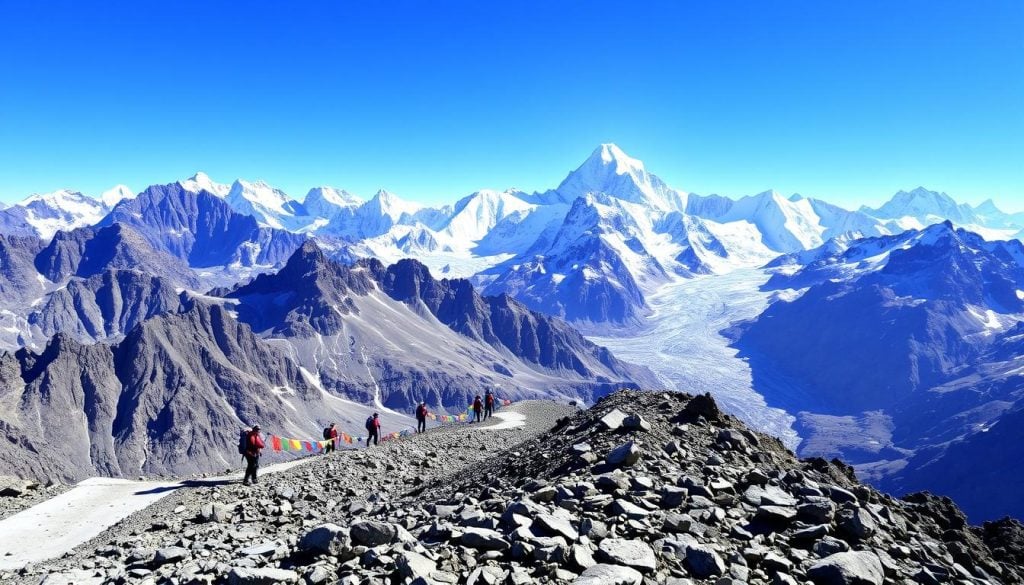
Sherpa Culture
Sherpa heritage adds a unique flavor to Everest treks. Local lodges are often run by people who have climbed Everest. You might meet families involved in guiding trekkers or carrying their gear. Talking with Sherpas, you learn about their traditions and enjoy their hospitality. Their stories and food enrich your adventure.
Tengboche Monastery
Tengboche Monastery stands tall at 3,870 meters. It’s a beacon of spirituality in Khumbu’s wild landscape. Every year, the monastery celebrates the Mani Rimdu festival. This attracts many visitors who come to soak in its spiritual energy. From here, you also get breathtaking views of Everest, Lhotse, and Ama Dablam.
The monastery is more than a beautiful place. It shows how nature and faith go hand in hand in Khumbu. It’s a key spot for anyone exploring Everest, symbolizing the heart of their journey.
Patan: The City of Artisans
Patan is famous for its stunning Newari architecture and traditional Nepalese crafts. The city’s heart, Patan Durbar Square, is a UNESCO World Heritage Site. It draws many visitors every day.
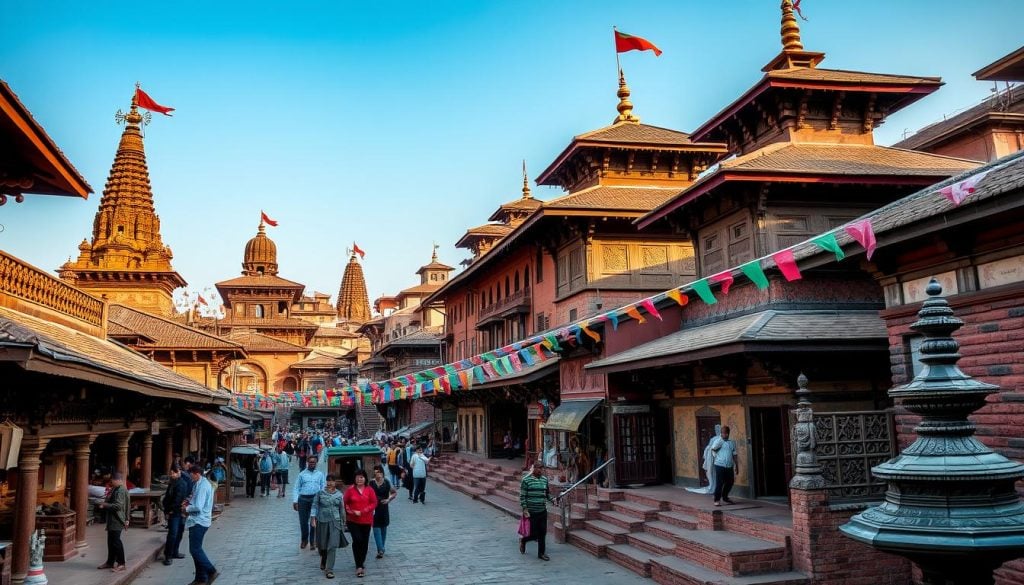
Patan Durbar Square
Patan Durbar Square is known for its beautiful palaces and temples. At its center, the palace complex includes the Patan Museum. This museum showcases an extensive collection of local artifacts and art.
The courtyards and statues around it are prime Newari architecture examples. They showcase Nepal’s traditional crafts.
Stone Krishna Temple
The Stone Krishna Temple is a key feature of Patan Durbar Square. Made entirely from stone, it’s celebrated for its precise carvings and sculptures. The temple exemplifies Newari craftsmanship.
Both devotees and art lovers come to enjoy its beautiful design and spiritual feel.
Sundari Chowk
Sundari Chowk is another highlight within Patan Durbar Square. It’s known for its beautiful water tank and stone statues. This area, encased by homes with Newari architecture, shows a blend of beauty and function. It gives a peek into traditional Nepalese crafts.
| Must-See Attractions | Details |
|---|---|
| Golden Temple | Built in the 12th century, known for its gold-plated roofs and intricate statues. |
| Mahabouddha Temple | Known as the ‘Temple of a Thousand Buddhas’, dating back to the 14th century. |
| Central Zoo | Located in Jawalakhel, it is noted as Nepal’s only zoo. |
| Godavari Botanical Gardens | Features a vast collection of plants and hosts the annual Rhododendron Festival. |
| Bungamati and Khokana Villages | Showcase traditional Newar life and crafts, offering authentic cultural experiences. |
| Pulchowk Street | Bustling with cultural, commercial, and culinary spots. |
Bhaktapur: The City of Devotees
Known as the ‘City of Devotees,’ Bhaktapur is a living showcase of medieval heritage in Nepal. It’s just 20 km away from Kathmandu. Visitors can step back in time to explore ancient culture and architecture.
Bhaktapur was Nepal’s capital until the late 15th century. It is filled with significant attractions. They offer a real look into the nation’s royal history.
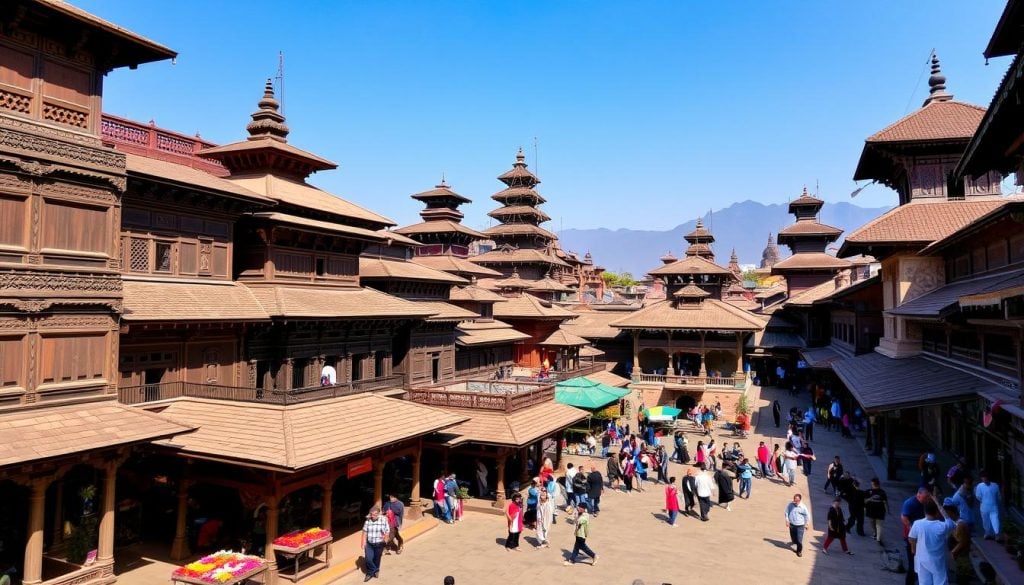
Durbar Square
Durbar Square is at the heart of Bhaktapur tourist attractions. It’s famous for its temples, statues, and Newari architecture. The Nyatapola Temple, a tall pagoda in the Kathmandu Valley, is here.
Visitors often see Shiva followers lighting candles and praying. They add to the square’s spiritual feel.
55-Window Palace
The 55-Window Palace is a must-see in Bhaktapur. It’s known for its beautiful wooden carvings. The palace is a symbol of Bhaktapur’s unique craftsmanship.
This palace shows Nepal’s rich art and history. Walking through, you’ll see intricate designs. They are a signature feature of this majestic place.
Boudhanath Stupa: A Major Pilgrimage Site
The Boudhanath Stupa is a key spiritual symbol in Nepal, known for its beauty and importance in Tibetan Buddhism. It’s one of the biggest spherical stupas in the world. Its detailed designs and meanings attract people from everywhere.
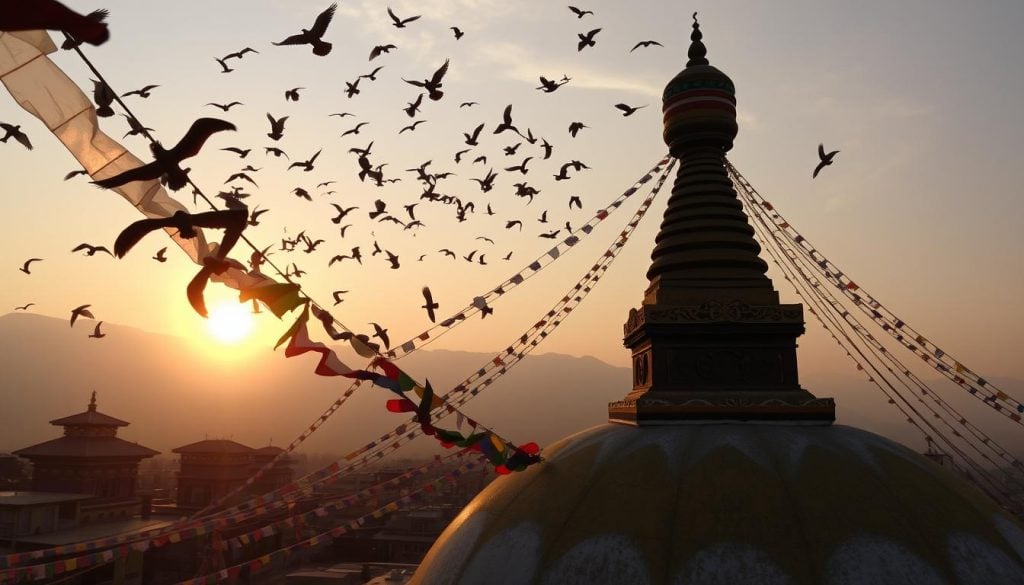
Architectural Symbolism
This stupa, built in the 5th century by Lichchhavi King Shiva Dev, has meaningful architecture. It showcases the elements of the five Buddhas—earth, water, fire, air, and space. These elements bring feelings of peace and togetherness. The Buddha’s eyes painted on it stand for wisdom and compassion. They seem to watch over everyone, encouraging a spiritual journey.
Cultural Significance
In 1979, the Boudhanath Stupa was declared a UNESCO World Heritage Site. It’s a key place for Tibetan Buddhism in Nepal. The area is full of monasteries where monks and others meditate and perform rituals.
Many pilgrims come here. They walk around the stupa, spin prayer wheels, and chant mantras with respect.
| Site | Significance | UNESCO Status |
|---|---|---|
| Boudhanath Stupa | Major Tibetan Buddhist pilgrimage site | World Heritage Site since 1979 |
| Swayambhunath Stupa | 2,000 years old historical site | World Heritage Site since 1979 |
| Lumbini | Birthplace of Buddha | World Heritage Site since 1997 |
The Boudhanath Stupa is not just a grand structure. It symbolizes unity, spirituality, and the deep influence of Tibetan Buddhism in Nepal.
10 Best Places to Visit in Nepal
Dive into the heart of the Himalayas with our list of must-visit spots in Nepal. From ancient temples to breathtaking treks, we highlight the diversity and allure of Nepal’s landscapes. This travel itinerary introduces you to Nepal’s stunning variety.
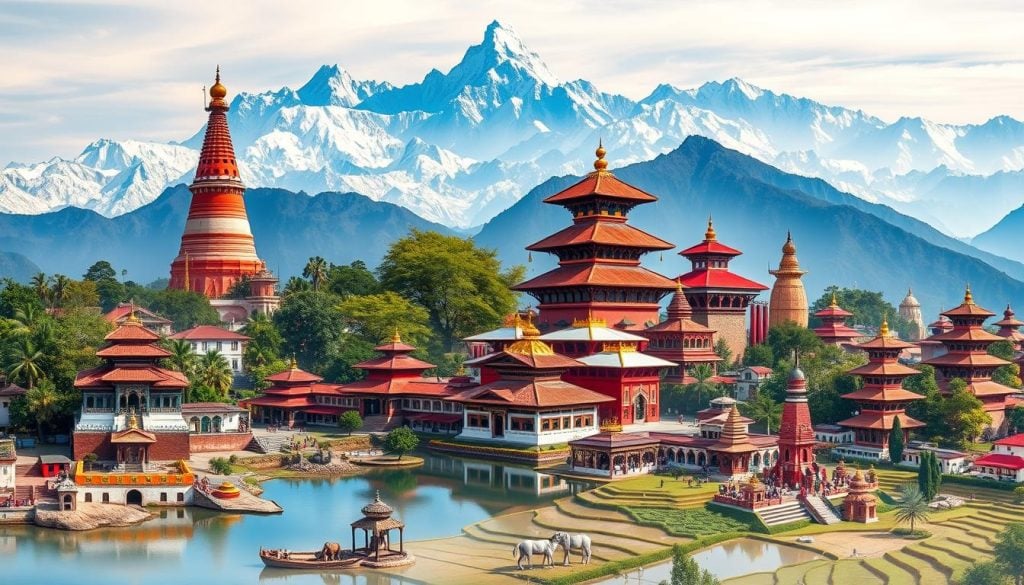
- Kathmandu Valley: Home to seven UNESCO World Heritage Sites, like the Swayambhunath Stupa and Pashupatinath Temple. The 2015 earthquake damaged it, but they remain key attractions. These places show Nepal’s rich history and culture.
- Pokhara: Known for Phewa Lake and the World Peace Pagoda, Pokhara blends tranquility with adventure. It’s the start of many treks and a top pick for nature lovers and trekkers.
- Chitwan National Park: At just 100 meters high, it’s a refuge for wildlife. It’s home to rare rhinos and tigers, making it great for wildlife fans.
- Annapurna Region: Offers treks like Annapurna Base Camp and Poon Hill. Two-thirds of Nepal’s trekkers come here. Since 1986, its diverse treks range from 4 to 21 days.
- Everest Base Camp: A dream for high-altitude adventurers, the trek takes you through amazing spots. You’ll see Namche Bazaar and enjoy breathtaking views from Kala Patthar.
- Lumbini: The Buddha’s birthplace, Lumbini, has the Maya Devi Temple and many monasteries. It’s peaceful and perfect for those interested in Buddhism.
- Janakpur: Known for its holy pools and Janaki Mandir, Janakpur is an ancient, spiritual city. It offers a unique blend of history and spirituality.
- Nagarkot: Famous for Himalayan views and sunrises, Nagarkot is a peaceful spot near Kathmandu. It’s ideal for experiencing the Himalayas’ majesty without the long treks.
- Khumbu Region: Home to Everest and rich in Sherpa culture, the region offers treks and cultural insights. You can visit the Tengboche Monastery here.
- Bhaktapur: The “City of Devotees,” Bhaktapur’s Durbar Square and 55-Window Palace remain vital despite earthquake damage. They are essential to Nepalese heritage and architecture.
| Destination | Altitude | Duration |
|---|---|---|
| Annapurna Base Camp | 4,130 meters (13,549 feet) | 7-12 days |
| Poon Hill Trek | 3,210 meters (10,531 feet) | 4-5 days |
| Everest Base Camp | 5,364 meters (17,598 feet) | 12-15 days |
| Annapurna Circuit | 5,416 meters (17,769 feet) | 10-21 days |
Nepal’s landscapes and cultural wealth offer something for every traveler. Whether it’s high-altitude treks, sacred spots, or serene nature, Nepal promises an adventure to remember. The country’s landmarks and travel highlights cater to all.
Machapuchare: The Sacred Mountain
Machapuchare, also known as the “Fish Tail” mountain, is truly magnificent. It rises 6,993 meters (22,943 feet) high in the Annapurna range. This peak is a sacred site in Nepal and is loved by locals and travelers. It’s about 25 kilometers (16 miles) north of Pokhara, offering amazing views and a rich history.
Out of respect, climbing Machapuchare is banned. The local Gurung community holds it sacred. In 1957, a British team led by Lieutenant Colonel Jimmy Roberts made a close attempt. Climbers Wilfrid Noyce and A.D.M. Cox got within 150 meters (492 feet) of the peak. But no one has been allowed to climb it since, to protect its holy status.
The journey to its base, the Annapurna Base Camp trek, is striking. It lets you deeply connect with Nepal’s natural beauty. The route goes through forests and alpine meadows. These offer memorable views. The trek is best from March to May and September to November. You’ll need an Annapurna Conservation Area Permit (ACAP) and a TIMS card for this adventure.
Walking through places like Ghorepani, Poon Hill, and Chhomrong reveals the area’s beauty and culture. Machapuchare blends spirituality, the thrill of adventure, and beautiful Himalayan scenery. It’s a top spot for anyone exploring Nepal.

































